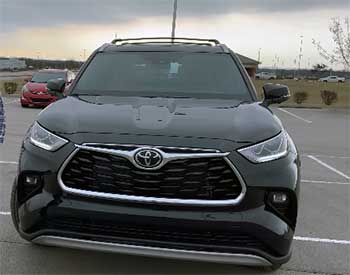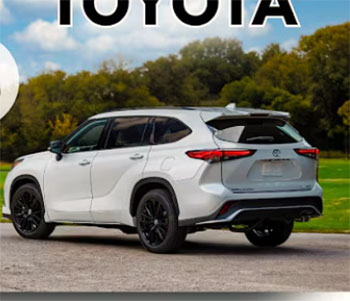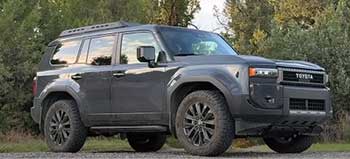
As a car enthusiast and a parent juggling family life, I’ve always been drawn to SUVs that promise versatility, reliability, and a touch of adventure.
Choosing between the Toyota Highlander and the Toyota Land Cruiser feels like picking between a trusty family companion and a rugged explorer.
My goal in this article is to compare these two Toyota giants, breaking down their features, performance, and practicality to help you decide which fits your lifestyle.
Whether you’re hauling kids to soccer practice or craving off-road thrills, I’ll share insights from my perspective to guide your choice.
Comparison Table: Toyota Highlander Vs. Toyota Land Cruiser
| Feature | Toyota Highlander | Toyota Land Cruiser |
|---|---|---|
| Starting Price | $41,815 | $58,195 |
| Engine Options | 3.5L V6, 2.5L Hybrid (240-295 hp) | 2.4L Turbo Hybrid (326 hp) |
| Fuel Economy | 22/29 MPG (city/highway, non-hybrid); 36 MPG combined (hybrid) | 22/25 MPG (city/highway) |
| Seating Capacity | Up to 8 | 5 (U.S. models) |
| Cargo Volume | 16 cu-ft (behind 3rd row), 84.3 cu-ft (max) | 37.5 cu-ft (behind 2nd row), 98 cu-ft (max) |
| Drive Type | FWD or AWD | 4WD standard |
| Off-Road Capability | Moderate (AWD models) | Excellent (full-time 4WD, high ground clearance) |
| Towing Capacity | Up to 5,000 lbs (non-hybrid) | Up to 6,000 lbs |
| Safety Features | Toyota Safety Sense 2.5+ (standard) | Toyota Safety Sense 2.5+, additional off-road safety |
| Interior Tech | 8-inch or 12.3-inch touchscreen, Apple CarPlay | 8-inch or 12.3-inch touchscreen, premium audio |
| Reliability Rating (iSeeCars) | 8.9/10 | 9.9/10 |
My Experience With Toyota Highlander
Driving the Toyota Highlander feels like slipping into a comfortable pair of shoes—familiar, reliable, and ready for daily life. I’ve taken it on family road trips, weaving through city traffic and cruising on highways, and it handles each scenario with ease.
The Highlander’s interior is spacious, especially in the second row, where my kids sprawl out without complaints. Its hybrid option, which I tested, delivers impressive fuel economy, making long drives less painful at the pump. The ride is smooth, almost car-like, which suits my daily commute and school runs perfectly.
However, the third row can feel cramped for adults, and I noticed it’s not ideal for long trips with a full load. The base engine, while adequate, doesn’t thrill, and I found myself wishing for more pep during highway merges.
Still, the Highlander’s tech, like the intuitive touchscreen and standard safety features, keeps things user-friendly. It’s a practical choice for families like mine, balancing cost, comfort, and efficiency without pretending to be an off-road beast.
Pros Of Toyota Highlander

- Affordable Starting Price: At $41,815, the Highlander is significantly cheaper than the Land Cruiser, making it accessible for budget-conscious families.
- Fuel Efficiency: The hybrid model achieves up to 36 MPG combined, perfect for cutting fuel costs on daily commutes or long trips.
- Spacious Interior: With seating for up to eight and 84.3 cubic feet of cargo space, it’s ideal for families needing room for kids, pets, or gear.
- Advanced Safety Features: Toyota Safety Sense 2.5+ includes lane departure warnings, adaptive cruise control, and pre-collision systems, boosting driver confidence.
- Versatile Drive Options: Available in front-wheel or all-wheel drive, it adapts to various weather conditions without requiring full-time 4WD.
- User-Friendly Technology: The 8-inch or optional 12.3-inch touchscreen supports Apple CarPlay and Android Auto, keeping everyone connected.
- Hybrid Availability: The 2.5L hybrid engine offers eco-friendly performance without sacrificing power, appealing to green-conscious drivers.
The Highlander’s affordability and efficiency make it a standout for families. I’ve found its hybrid model especially appealing, saving me money on gas while still offering enough power for daily driving. The spacious interior easily handles my family’s gear, from sports equipment to groceries, and the safety features give me peace of mind with kids in the back. While it’s not perfect, the Highlander’s balance of practicality and modern tech makes it a reliable daily driver that doesn’t break the bank.
Cons Of Toyota Highlander
- Cramped Third Row: The third row is tight for adults, limiting its use for long trips or larger passengers.
- Underpowered Base Engine: The 3.5L V6 (295 hp) feels sluggish during quick acceleration, especially when fully loaded.
- Limited Off-Road Capability: While AWD helps in light snow or gravel, it’s not built for rugged terrain like the Land Cruiser.
- Higher Depreciation: Loses 39.2% of its value over five years, compared to the Land Cruiser’s 36.2%, impacting resale value.
- Noise at High Speeds: Some road and wind noise creeps into the cabin on highways, which can detract from the premium feel.
- Smaller Cargo Behind Third Row: Only 16 cubic feet of cargo space with all seats up, less practical for bulky items.
- Less Prestigious Image: Compared to the Land Cruiser’s iconic status, the Highlander feels more like a mainstream family SUV.
The Highlander’s third-row limitations were noticeable when I tried fitting adult friends for a road trip—it’s better suited for kids. The base engine’s lack of punch also stood out when I needed quick acceleration, and the cargo space behind the third row struggled with larger items like strollers. While these drawbacks don’t ruin the experience, they make the Highlander less versatile for specific needs, especially if you’re eyeing off-road adventures or a more upscale image.
Also read: My Thoughts on Acura ILX Vs. Honda Accord
Maintenance Tips For Toyota Highlander
- Regular Oil Changes: Change the oil every 5,000-7,500 miles for non-hybrid models and 10,000 miles for hybrids to maintain engine health.
- Tire Rotation and Alignment: Rotate tires every 6,000 miles and check alignment annually to ensure even wear and better handling.
- Brake Inspections: Inspect brakes every 15,000 miles, as the Highlander’s weight can stress pads, especially in stop-and-go traffic.
- Air Filter Replacement: Replace cabin and engine air filters every 12,000-15,000 miles to maintain air quality and engine efficiency.
- Battery Maintenance: For hybrids, check the battery cooling system yearly to prevent overheating and extend battery life.
- Fluid Checks: Monitor coolant, transmission, and brake fluids every 30,000 miles to avoid costly repairs and ensure smooth operation.
- Software Updates: Keep the infotainment and safety systems updated through Toyota’s service centers for optimal performance.
- Rust Prevention: Wash the undercarriage regularly, especially in snowy regions, to protect against rust from road salt.
These steps have kept my Highlander running smoothly, especially the hybrid’s battery maintenance, which can be a game-changer for long-term savings. Regular care ensures the Highlander’s reliability, though I’ve found hybrid models require slightly more attention to electrical components. Staying on top of tire rotations and fluid checks has also helped me avoid unexpected issues, keeping the vehicle ready for family adventures or daily commutes.
My Experience With Toyota Land Cruiser
Taking the Toyota Land Cruiser off-road was like unleashing a beast built for adventure. I drove it through muddy trails and rocky paths, and its full-time 4WD and high ground clearance made every obstacle feel conquerable. The cabin feels premium, with durable materials that scream longevity. Its hybrid powertrain, delivering 326 horsepower, gave me plenty of grunt for towing and climbing steep inclines. On highways, it’s stable but not as plush as the Highlander, with a stiffer ride that reminds you of its off-road DNA.
That said, the Land Cruiser’s price tag stung, and its fuel economy—22/25 MPG—made me wince at the pump. The two-row setup in the U.S. model limited its family appeal, and I missed the Highlander’s third row for extra passengers. Still, its legendary reliability and off-road prowess make it a dream for adventure seekers like me who occasionally escape the suburbs for rugged terrain.
Pros Of Toyota Land Cruiser

- Superior Off-Road Capability: Full-time 4WD, 23.5 cm ground clearance, and rugged suspension tackle tough terrains effortlessly.
- Powerful Hybrid Engine: The 2.4L turbo hybrid delivers 326 hp and 465 lb-ft of torque, ideal for towing up to 6,000 lbs.
- Exceptional Reliability: Scores 9.9/10 on iSeeCars’ reliability rating, outshining the Highlander’s 8.9/10 for long-term durability.
- Strong Resale Value: Retains 63.8% of its value after five years, better than the Highlander’s 60.8%, making it a smarter investment.
- Premium Interior: High-quality materials and optional premium audio create a luxurious, durable cabin for long journeys.
- Advanced Safety Suite: Includes Toyota Safety Sense 2.5+ plus off-road-specific features like hill start assist and traction control.
- Iconic Legacy: Its decades-long reputation as a rugged, reliable SUV adds prestige and appeal for enthusiasts.
The Land Cruiser’s off-road capability blew me away on a weekend trip through a rocky state park—it handled everything I threw at it. The hybrid engine’s torque made towing a trailer feel effortless, and the interior’s durability gave me confidence it could withstand years of use. Its reliability and resale value are huge pluses, especially if you plan to keep it long-term. For those who value adventure and prestige, the Land Cruiser feels like a legacy vehicle that’s hard to match.
Cons Of Toyota Land Cruiser
- High Starting Price: At $58,195, it’s significantly pricier than the Highlander, limiting its appeal for budget buyers.
- Poor Fuel Economy: Only 22/25 MPG (city/highway), far less efficient than the Highlander’s hybrid option.
- Limited Seating: U.S. models offer only five seats, reducing its practicality for larger families.
- Stiff Ride on Pavement: The off-road-focused suspension makes highway drives less comfortable than the Highlander.
- Higher Maintenance Costs: Off-road components and premium parts can lead to pricier repairs compared to the Highlander.
- Less Cargo Behind Seats: While max cargo is 98 cu-ft, the standard 37.5 cu-ft is less practical with passengers.
- Limited Availability: High demand and low supply can make finding a Land Cruiser challenging.
The Land Cruiser’s price and fuel costs hit hard, especially for daily driving. I felt the limited seating when I couldn’t fit extra passengers for a group outing, and the stiff ride was noticeable on long highway stretches. Maintenance costs also add up if you’re frequently off-roading, and finding one at a dealership can be a hassle due to its popularity. These factors make it less practical for everyday family use compared to the Highlander.
Maintenance Tips For Toyota Land Cruiser
- Check 4WD System: Inspect the four-wheel-drive components every 20,000 miles to ensure off-road performance remains optimal.
- Oil and Filter Changes: Use synthetic oil and change every 5,000 miles due to the engine’s demands in rugged conditions.
- Suspension Inspections: Check shocks and struts every 15,000 miles, as off-roading can accelerate wear on these parts.
- Tire Maintenance: Rotate tires every 5,000 miles and monitor tread depth for off-road grip and highway safety.
- Cooling System Care: Flush coolant every 40,000 miles to prevent overheating during heavy towing or off-road use.
- Differential Fluid: Replace front and rear differential fluid every 30,000 miles to maintain 4WD efficiency.
- Brake System Checks: Inspect brakes every 10,000 miles, as off-road debris can cause faster wear.
- Clean Underbody: Rinse mud and dirt from the undercarriage after off-roading to prevent corrosion.
I’ve found these steps crucial for keeping the Land Cruiser ready for adventure. The 4WD system and suspension need extra attention if you’re frequently off-road, but they ensure the vehicle’s legendary durability. Regular cleaning after trail runs has also saved me from rust issues, and keeping up with brake checks prevents surprises in tough conditions. These habits maximize the Land Cruiser’s lifespan and performance.
Comparison With Other Brands
- Honda Pilot: Offers similar family-friendly space as the Highlander with up to eight seats, but its 3.5L V6 (285 hp) lacks a hybrid option, and off-road capability is weaker than the Land Cruiser.
- Jeep Grand Cherokee: Matches the Land Cruiser’s off-road prowess with its Quadra-Trac 4WD, but its reliability (7.8/10 iSeeCars) trails both Toyotas, and interior quality feels less premium.
- Ford Explorer: Provides comparable towing (5,600 lbs) to the Land Cruiser and seating like the Highlander, but its tech interface is less intuitive, and fuel economy lags behind the Highlander hybrid.
- Kia Telluride: Rivals the Highlander’s family appeal with a spacious cabin and 291 hp V6, but its AWD system isn’t as robust as the Land Cruiser’s 4WD for serious off-roading.
- Chevrolet Traverse: Offers more cargo space (98.2 cu-ft max) than both Toyotas, but its 3.6L V6 (310 hp) has lower fuel efficiency, and it lacks the Land Cruiser’s off-road credentials.
- Lexus GX: Shares the Land Cruiser’s off-road DNA and premium interior but starts at $62,900, pricier than both, with less family-friendly seating than the Highlander.
- Subaru Ascent: Matches the Highlander’s AWD and seating but has a weaker 2.4L turbo engine (260 hp) and less cargo space, making it less versatile than either Toyota.
Comparing these SUVs to the Highlander and Land Cruiser highlights their unique strengths. The Highlander competes well with family-focused rivals like the Pilot and Telluride, offering better fuel economy and tech. The Land Cruiser stands out against off-roaders like the Grand Cherokee and GX, with superior reliability and a storied legacy. Your choice depends on whether you need a daily driver or an adventure-ready rig.
Read more: My Thoughts on GMC Terrain Vs. Ford Escape
Frequently Asked Questions (FAQ)
The Highlander is a family-oriented midsize SUV with seating for up to eight, better fuel economy (up to 36 MPG hybrid), and a lower price ($41,815). The Land Cruiser is a premium, off-road-focused SUV with full-time 4WD, five seats in the U.S., and a higher price ($58,195).
Toyota discontinued the Land Cruiser in the U.S. after 2021 due to low sales and high costs but reintroduced it in 2024 as the J250 model, focusing on hybrid efficiency and off-road capability.
The Land Cruiser (495 cm long, 198 cm wide) is slightly shorter but wider than the Grand Highlander (501.4 cm long, 193 cm wide). The Grand Highlander offers more interior space with three rows, while the Land Cruiser has two rows in the U.S.
Its high price ($58,195), poor fuel economy (22/25 MPG), limited five-seat capacity, stiff ride on pavement, higher maintenance costs, and limited availability are key drawbacks.
Conclusion: For Toyota Highlander And Land Cruiser
You’re likely torn between the Toyota Highlander’s practicality and the Land Cruiser’s rugged allure. If your life revolves around family duties, city driving, or saving on fuel, the Highlander’s affordability, hybrid efficiency, and spacious cabin make it your go-to.
But if you crave off-road adventures or value long-term reliability and resale value, the Land Cruiser’s unmatched capability and iconic status are hard to beat. I’ve loved both for different reasons—Highlander for daily ease, Land Cruiser for epic escapes. Your choice depends on whether you prioritize comfort or conquest.

